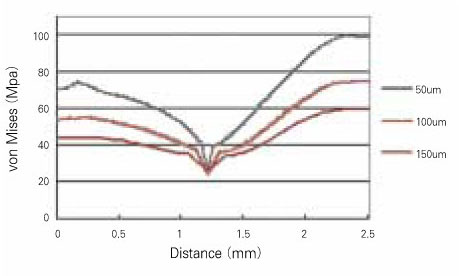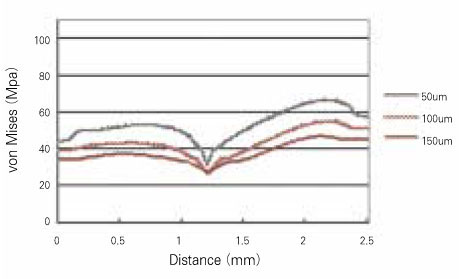Articles
- Page Path
- HOME > Restor Dent Endod > Volume 34(5); 2009 > Article
- Original Article The effects of dentin bonding agent thickness on stress distribution of composite-tooth interface : Finite element method
- Sang-Il Park, Yemi Kim, Byoung-Duk Roh
-
2009;34(5):-449.
DOI: https://doi.org/10.5395/JKACD.2009.34.5.442
Published online: September 30, 2009
Department of Conservative Dentistry, College of Dentistry, Yonsei University, Korea.
- Corresponding author: Byoung-Duk Roh. Department of Conservative Dentistry, College of Dentistry, Yonsei University, 134 Shinchon-dong, Seodamun-gu, Seoul, 120-752, Korea. Tel: 82-2-2228-3146, Fax: 82-2-313-7575, operatys16@yuhs.ac
• Received: July 24, 2009 • Revised: August 15, 2009 • Accepted: August 22, 2009
Copyright © 2009 The Korean Academy of Conservative Dentistry
- 1,106 Views
- 2 Download
- 1 Crossref
Abstract
-
The aim of this study was to examine that thick dentin bonding agent application or low modulus composite restoration could reduce stresses on dentin bonding agent layer.A mandibular first premolar with abfraction lesion was modeled by finite element method. The lesion was restored by different composite resins with variable dentin bonding agent thickness (50µm, 100µm, 150µm). 170N of occlusal loading was applied buccally or lingually. Von Mises stress on dentin bonding agent layer were measured.When thickness of dentin bonding agent was increased von Mises stresses at dentin bonding agent were decreased in both composites. Lower elastic modulus composite restoration showed decreased von Mises stresses. On root dentin margin more stresses were generated than enamel margin.For occlusal stress relief at dentin boning agent layer to applicate thick dentin bonding agent or to choose low elastic modulus composite is recommended.
- 1. Grippo JO. Abfractions : a new classification of hard tissue lesions of teeth. J Esthet Dent. 1991;3: 14-19.ArticlePubMed
- 2. Heymann HO. Examining tooth flexure effects. JADA. 1991;122: 41-47.
- 3. Lee WC, Eakle WS. Possible role of tensile stress in the etiology of cervical erosive lesions of teeth. J Prosthet Dent. 1984;52: 374-380.ArticlePubMed
- 4. Stewart GP, Balda BA, Norman RD. The effects of mechanical loading on marginal integrity of composite restorations. Dent Mater. 1986;2: 151-152.ArticlePubMed
- 5. Sturdevant JR, Lundeen TF, Sluder TB, Leinfelder KF. Three-year study of two light-cured posterior composite resins. Dent Mater. 1986;2: 263-268.ArticlePubMed
- 6. McCoy RB, Anderson MH, Lepe X, Jonson GH. Clinical success of class V composite resin restorations without mechanical retention. JADA. 1998;129: 593-599.ArticlePubMed
- 7. Mattison GD. Photoelastic stress analysis of cast gold endodontic posts. J Prosthet Dent. 1982;48: 407-411.ArticlePubMed
- 8. Assif D, Oren E, Marshak BL, Aviv I. Photoelastic analysis of stress transfer by endodontically treated teeth to the supporting structures using different restorative technique. J Prosthet Dent. 1989;61: 535-543.PubMed
- 9. Kuroe T, Itoh H, Caputo AA, Konuma M. Biomechanincs of cervical tooth structure lesions and their restoration. Quintessence Int. 2000;31: 267-274.PubMed
- 10. Um CM, Kwon HC, Son HH, Cho BH, Rim YI. Finite element analysis of stress distribution according to cavity design of class v composite resin filling. J Korean Acad Conserv Dent. 1999;24: 67-75.
- 11. Turner MJ, Clough RW, Martin HC, Topp LJ. Stiffness and deflection analysis of complex structure. J Aero Sci. 1956;23: 805-823.
- 12. Ausiello P, Apicella A, Davidson CL. Effect of adhesive layer properties on stress distribution in composite restorations-a 3D finite element analysis. Dent Mater. 2002;18: 295-303.ArticlePubMed
- 13. Rees JS. The effect of variation in occlusal loading on the development of abfraction lesions : a finite element study. J Oral Rehabil. 2002;29: 188-193.ArticlePubMed
- 14. Yaman SD, Sahin M, Aydin C. Finite element analysis of strength characteristics of various resin based restorative materials in class V cavities. J Oral Rehabil. 2003;30: 630-641.ArticlePubMedPDF
- 15. Chon CS, Kim HS, Shim JS, Kim YH. Finite element knalysis for elastic modulus of the periodontal ligament in premolar regions. J Korean Soc Precision Eng. 2005;22: 202-209.
- 16. Van Meerbeek B, Willems G, Celis JP, Roos JR, Braem M, Lambrechts P, Vanherle G. Assesment by nano-indentation of the hardness and elasticity of the resin-dentin bonding area. J Dent Res. 1993;72: 1434-1442.ArticlePubMedPDF
- 17. Moon PC, Chang YH. Effect of DBA layer thickness on composite resin shrinkage stress. J Dent Res. 1992;71: 275-283.
- 18. Choi KK, Cordon JR, Ferracane JL. The effects of adhesive thickness on polymerization contraction stress of composite. J Dent Res. 2000;79: 812-817.ArticlePubMedPDF
- 19. Peter A, Paul SJ, Luthy H, Scharer P. Film thickness of various dentin bonding agents. J Oral Rehabil. 1997;24: 568-573.ArticlePubMed
- 20. Cho BH, Yoo HM, Kim DH. Two-dimensional finite element analysis on the effect of interface condition and retention groove in class v composite resin restoration. J Korean Acad Conserv Dent. 1998;23: 639-646.
- 21. Rees JS. Abfraction lesion formation in maxillary incisors, canines and premolars: A finite element study. Eur J Oral Sci. 2003;111: 149-154.ArticlePubMedPDF
- 22. Widmalm SE, Ericsson SG. Maximal bite force with centric and eccentric load. J Oral Rehabil. 1982;9: 445-450.ArticlePubMed
- 23. Gibbs CH, Mahan PE, Lundeen HC, Brehnan K, Walsh EK, Holbrook WB. Occlusal force during chewing and swallowing as measured by sound transmission. J Prosthet Dent. 1981;46: 443-449.PubMed
REFERENCES
Tables & Figures
REFERENCES
Citations
Citations to this article as recorded by 

- Influence of application methods of one-step self-etching adhesives on microtensile bond strength
Chul-Kyu Choi, Sung-Ae Son, Jin-Hee Ha, Bock Hur, Hyeon-Cheol Kim, Yong-Hun Kwon, Jeong-Kil Park
Journal of Korean Academy of Conservative Dentistry.2011; 36(3): 203. CrossRef
The effects of dentin bonding agent thickness on stress distribution of composite-tooth interface : Finite element method







Figure 1
2-D finite element model simulated in this study.
Figure 2
von Mises stress at Z100 when buccal loading applied
Figure 3
von Mises stress at Tetric Flow when buccal loading applied
Figure 4
von Mises stress at Z100 when lingual loading applied
Figure 5
von Mises stress at Tetric Flow when lingual loading applied
Figure 6
Principal stress vectors on adhesive when buccal loading applied
Figure 7
Principal stress vectors on adhesive when lingual loading applied
Figure 1
Figure 2
Figure 3
Figure 4
Figure 5
Figure 6
Figure 7
The effects of dentin bonding agent thickness on stress distribution of composite-tooth interface : Finite element method
Experimental models used in this study
a3M Dental Products, St. Paul, USA
bIvoclar Vivadent, FL-9494-Schaan, Liechtenstein
cKerr, Orange, CA, USA
Mechanical properties of the materials used in the study
Table 1
Experimental models used in this study
a3M Dental Products, St. Paul, USA bIvoclar Vivadent, FL-9494-Schaan, Liechtenstein cKerr, Orange, CA, USA
Table 2
Mechanical properties of the materials used in the study

 KACD
KACD









 ePub Link
ePub Link Cite
Cite

